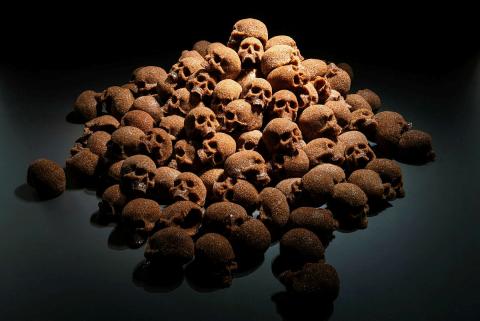Togo-Brisby: Bitter sweet
By Ruth McDougall Moale James
Artlines | 1-2024 | March 2024
Editor: Stephanie Kennard
This installation work by Jasmine Togo-Brisby, which was acquired in 2022 for the Collection with funds from the Contemporary Patrons through the QAGOMA Foundation, highlights Queensland’s cultural and social landscape by revealing the story of a community that suffered terribly through the formative years of this state. Here, ‘sis: Pacific Art 1980–2023’ lead curator Ruth McDougall and ‘sis’ curatorial team member Moale James expand on this emotive work, which appears in exhibition’s new rotation from March.
In 2015, Brisbane-based artist Jasmine Togo-Brisby began researching the Pacific labour trade in Australia and how this intersected with her own familial history as a fourth-generation Australian South Sea Islander person. Her haunting sculptural installation, titled Bitter sweet, comprises a large mound of skulls. Cast in unrefined CSR sugar, they reference the 60 000 Pacific Islanders who were kidnapped, enslaved and brought to Queensland between 1863 and 1904 as labourers for the sugarcane plantations.1 In the tradition of the Ni‑Vanuatu communities from which Togo-Brisby descends, the 156 skulls of the work represent the many ancestral figures who died during their journey, in the holds of ships, or as a result of the inhuman conditions in which they were forced to exist once they arrived in Australia. Tragically, for their descendants, most of the people lost were buried in unmarked graves. Working with family recollections, intergenerational trauma, the discovery of ancestral remains on plantations, and drawing on vitally important healing practices, Togo-Brisby is one of very few Islander artists delving into shared histories of plantation colonisation across the Pacific.
Truth-telling has become an integral act of educating the wider community about colonialism and systemic racism. Truth-telling allows for the reshaping of past narratives and acts as a stepping stone to a future that elevates diverse voices and a process of healing. Togo-Brisby’s great-great-grandparents were taken from Vanuatu as part of Australia’s slave trade, known as ‘blackbirding’, which began in the mid-1800s. At the age of eight, her greatgreat- grandmother was forcibly removed from her family and her community to work as a ‘domestic’ for the Wunderlich family in 1899.2 Memories of this traumatic time are not stories from a distant history; rather, these memories relate to events that, in some cases, are only a generation past. Togo-Brisby’s practice can be confronting and chilling as it presents the human face of suffering and loss inherent in Australia’s slave-trading history, particularly its generational repercussions.
On the eve of the 150th anniversary of the recognition of Australian South Sea Islanders as a distinct cultural group, an unmarked mass grave was discovered on a Bundaberg sugar plantation.3 Togo-Brisby responded with Bitter sweet. Art historian Kirsty Baker describes the work’s power: ‘The use of sugar as a medium works on this metaphoric level, its sickly-sweet aroma dramatically heightening the horror of the subject matter’.4
Togo-Brisby uses archival research and stories passed down from her grandmother as anchors for her work. Sometimes this way of working can trigger confronting memories, but she says her practice is about empowerment and hope, rather than trauma and its long-term effects. Togo-Brisby’s relationships with her Elders — specifically the women in her lineage — profoundly shape her work. Togo-Brisby has shared that sometimes the ideas for her work feel like they come from ‘somewhere else’, another time and place.5 Perhaps there is a place in our spirit where we are connected to all the women who have come before us and all those who will come after us — a shared consciousness where memories of the past and hopes for the future are found. Perhaps this is the place where we will sit with our Elders, sharing stories of our lived existence.
Bitter sweet acknowledges those who suffered the extreme inhumanity of Queensland’s early agriculture industry. The work is a powerful and important reminder to viewers of the state’s grim and often overlooked history.
Ruth McDougall is Curator, Pacific Art, and lead curator of ‘sis: Pacific Art 1980–2023’. Moale James is a Papua New Guinean–Australian storyteller and independent curator, and a member of the ‘sis’ curatorial team. This text is a combined, edited excerpt of works by both contributors, which feature in the exhibition publication sis: Pacific Art 1980–2023, available for purchase from the QAGOMA Stores.
Endnotes
- Will Higginbotham, ‘Blackbirding: Australia’s history of luring, tricking and kidnapping Pacific Islanders’, ABC News, 17 September 2017 viewed August 2022.
- Jasmine Togo-Brisby, ‘Dear Mrs Wunderlich’, Page Galleries: Page 1987, 23 July 2020, viewed February 2023.
- John Taylor, ‘Service honours heritage-listed South Sea Islanders gravesite in Bundaberg’, ABC News, 16 August 2013, viewed March 2023.
- Kirsty Baker, ‘Jasmine Togo-Brisby’, Artist Profile, no.55, 2021, , viewed February 2023.
- Jasmine Togo-Brisby, conversation with the author, Brisbane, 1 November 2022.
Connected objects

Bitter sweet 2015
- TOGO-BRISBY, Jasmine - Creator
Metadata, copyright and sharing information
About this story
- Subject